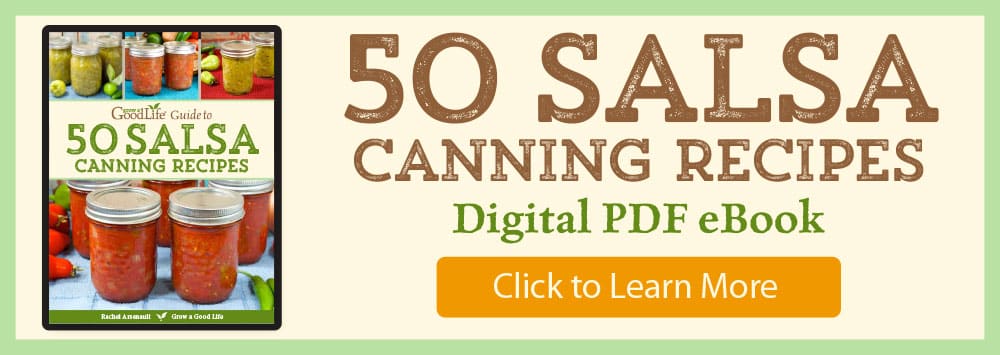Evaluating Canning Recipes: How to Tell if a Canning Recipe is Safe
This post may contain affiliate links, which means that I may receive a commission if you make a purchase using these links. As an Amazon Associate I earn from qualifying purchases.
Not all canning recipes are safe to follow. Learn how to determine if a canning recipe has been tested and is safe, identify common red flags, and find trusted sources for safe home food preservation.
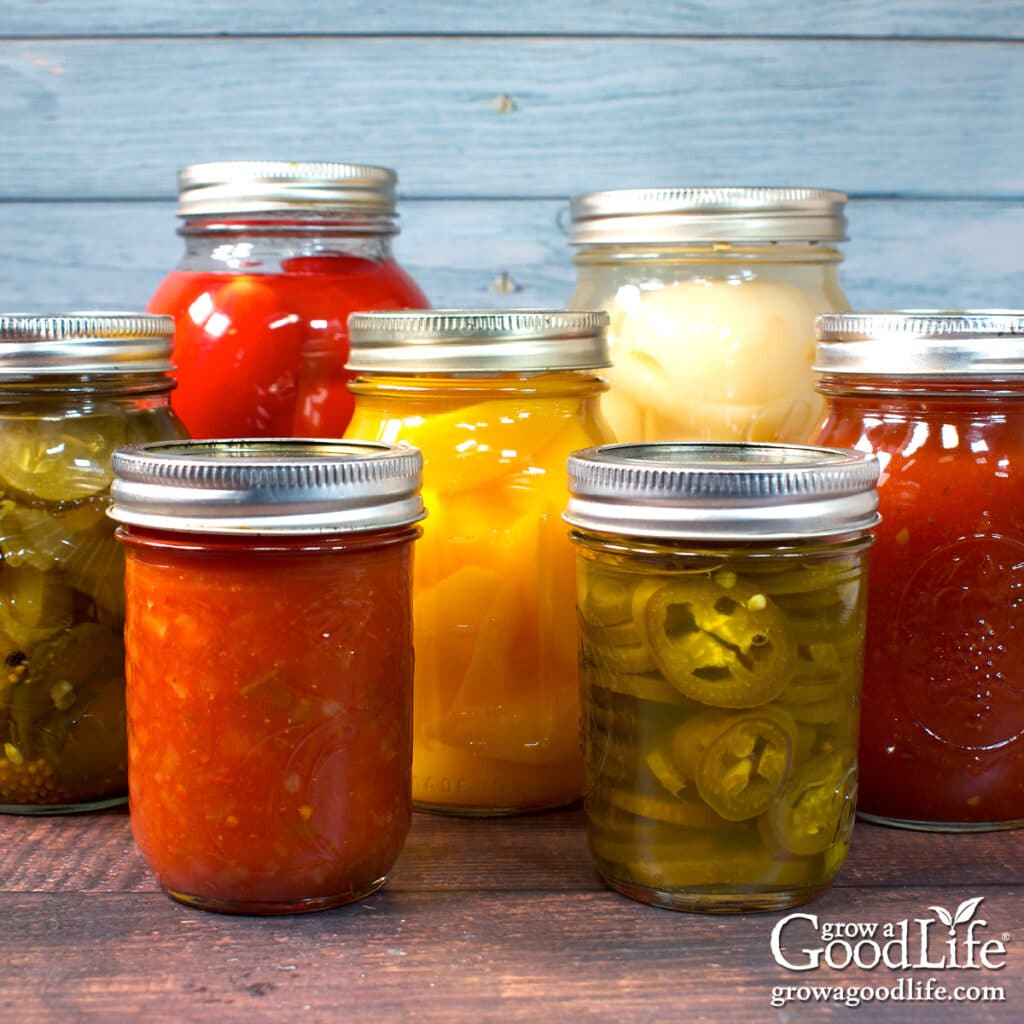
So, you have a bumper crop from your garden, and you want to preserve the abundance to enjoy later. Or maybe you’ve come across a delicious-sounding canning recipe passed down through your family or found something interesting online. You’re excited to try it, but there’s one important question you need to ask:
Is this recipe actually safe to can?
As someone who teaches and shares about home food preservation, I strongly believe we have a responsibility to do so safely. Most of us aren’t food scientists, we’re home canners following trusted, tested guidelines just like you. And while we try our best, it’s not always easy. Some recipes are vague and leave a lot open to interpretation. Even experienced canners can feel unsure sometimes.
In this guide, you’ll learn how to evaluate a canning recipe and tell whether it is safe to use. We also cover signs of a tested recipe, red flags to avoid, and where to find trustworthy resources so you can preserve your harvest with confidence.
Why Recipe Safety Matters
Home canning is a time-honored and rewarding way to preserve food, but when done incorrectly, it can be dangerous. Improper methods or unsafe recipes can lead to foodborne illness or even botulism, a potentially deadly toxin that cannot be seen, smelled, or tasted. Just because a jar seals doesn’t mean the contents are safe. Safe preservation depends on correct processing, not just a pop of the lid.
It’s easy to assume that a recipe from a friend, family member, or website is safe, but unless it comes from a lab-tested source, it may not be worth the risk. Fortunately, there are clear signs to look for to help you decide whether to trust a recipe.
How to Spot a Safe Recipe
A safe canning recipe is one that has been scientifically tested to ensure it eliminates harmful bacteria and molds, creating a shelf-stable product.
Here are common features of reliable recipes:
- Clear processing method: Water bath canning for high-acid foods; pressure canning for low-acid foods.
- Specified jar size and headspace: Safe recipes are tested using specific jar sizes (usually half-pint, pint, or quart), and they specify the amount of empty space to leave at the top between the food and cover.
- Precise processing time and altitude adjustment: These times ensure food reaches the necessary internal temperature for safety. Altitude matters and should be accounted for.
- Acidification instructions are provided when needed: For example, tested tomato recipes will instruct you to add bottled lemon juice or citric acid.
- Preparation details that affect safety: Such as warming jars, peeling tomatoes, heating and hot-packing certain foods, or avoiding added thickeners.
- Call for approved canning jars and lids: Only approved standard canning jars with two-piece lids are safe for canning. Avoid reusing commercial jars, as they may break. Do not reuse lids, as they may not seal properly.
- Stick with recipes from reputable sources such as the USDA, Extension Services, Ball, or Bernardin.
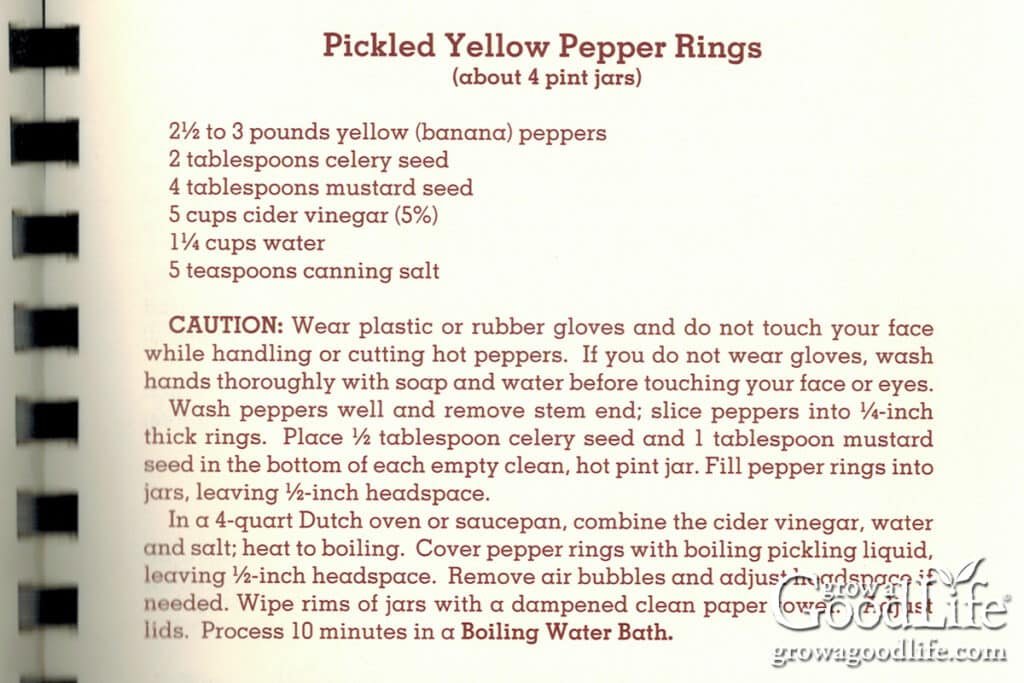
Red Flags to Avoid in a Canning Recipe
Not all recipes, even beautiful or nostalgic ones, are created with food safety in mind. You might hear folks say, “No one’s died yet from this recipe,” especially when it’s been passed down through generations.
While it’s natural to trust the recipes our grandmothers used, food safety science has advanced significantly since then. Just because no one in the family has gotten sick from improperly canned food doesn’t mean the risk isn’t real.
Following lab-tested recipes from trusted sources is the only way to be sure your home-canned food is truly safe for you and your loved ones.
Watch out for the following warning signs:
- No processing method or time listed: If a recipe doesn’t clearly say how long to process the jars and which method to use (water bath or pressure canning), it hasn’t been tested for safety.
- Vague or outdated instructions: Phrases like “process as usual,” “seal while hot,” or “boil until done” are unclear and may skip critical safety steps.
- Unsafe canning methods: Techniques such as oven canning, open-kettle canning (pouring hot food into jars and sealing without processing), dry canning, and dishwasher canning are all considered unsafe. Paraffin wax sealing was once popular but is now considered unsafe and outdated. They don’t get hot enough or process long enough to kill harmful bacteria.
- Uses unapproved ingredients: Recipes that include flour, cornstarch, butter, milk, cream, rice, or pasta can alter the density of the food, interfere with heat penetration, and create unsafe conditions inside the jar.
- Unsafe ingredient changes: Adding extra low-acid ingredients like onions, garlic, peppers, celery or increasing their amounts beyond what the recipe calls for can tip the balance of acidity and make a recipe unsafe for water bath canning.
- Filling jars without proper processing: Some recipes suggest filling jars with hot food and letting them seal on their own without using a water bath or pressure canner. This may cause the lid to seal due to heat, but the contents have not been processed to kill dangerous bacteria.
Even if the jar seals, an unsafe process can leave dangerous bacteria behind.
How to Evaluate If a Canning Recipe Is Safe
Not all canning recipes, whether passed down from a friend, found in a canning cookbook, or discovered online, can be trusted for food safety. You may see recipes labeled as “safe” or “based on USDA guidelines,” but that alone isn’t enough. Interpreting recipes, especially online, can be frustrating. Even well-meaning sources sometimes oversimplify or misrepresent the rules.
If the recipe comes directly from a trusted source, such as the National Center for Home Food Preservation, university Extension Services, Ball, or Bernardin, and is followed exactly as written, it’s considered safe.
You can find a full list of reliable sources here: Safe Canning Resources: Trusted Guides for Home Food Preservation.
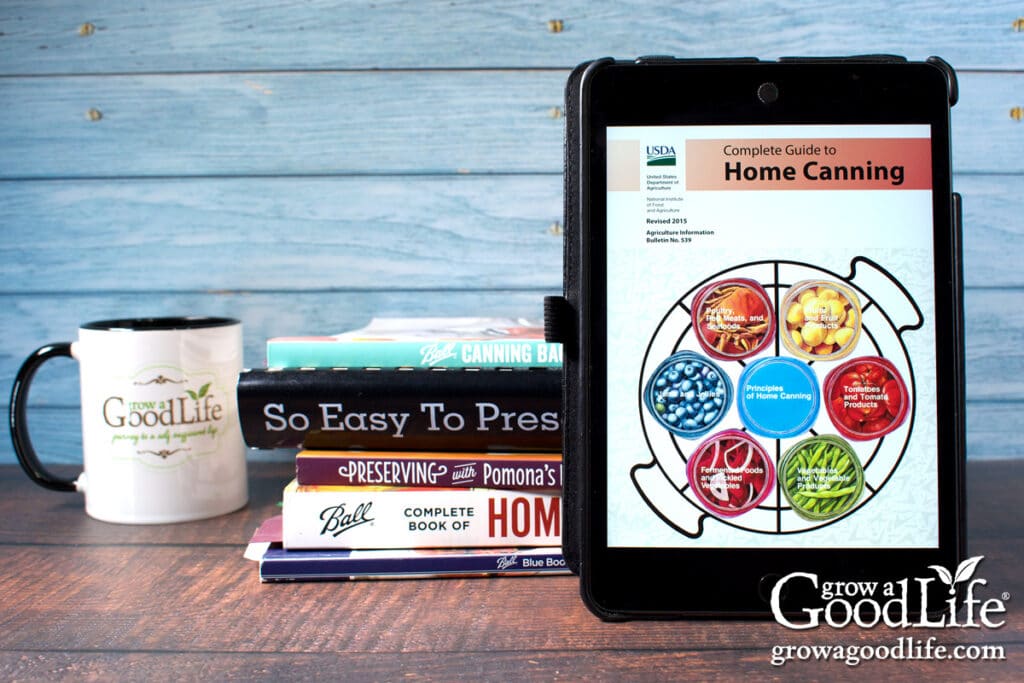
But what if the recipe doesn’t come from one of those trusted sources? Even if it looks credible or comes from someone you know, it’s important to make sure it follows current, science-based canning practices.
Here’s how to evaluate whether or not a canning recipe is truly safe to use:
Step 1: Check the Source
A safe recipe should clearly state where it came from. Look for a note like: “Adapted from the USDA Complete Guide to Home Canning.”
If there’s no mention of a source or if it simply says “based on a USDA recipe,” approach it with caution.
Step 2: Compare Against the Original
If a source is listed, try to find the original version from a trusted guide or online and compare the following details:
- Ingredients: Are the quantities the same?
- Jar size: Does it specify pints, quarts, or half-pints? And does that match the original recipe?
- Preparation instructions: Are they clear and do they match safe practices (e.g., peeling tomatoes, hot packing)?
- Canning method: Is it using water bath or pressure canning appropriately based on the acidity of the food?
- Headspace: Is the recommended headspace specified?
- Processing time and altitude adjustments: Are the listed times accurate, do they align with the original recipe, and do they account for elevation?
Even slight differences can make a recipe unsafe if they affect acidity, density, or heat penetration.
Step 3: Understand What You Can (and Can’t) Change
Some small tweaks in a canning recipe are safe to make. Others can compromise the acidity level, density, or heat penetration, making the food unsafe for shelf storage. Here’s a general guide to help you tell the difference:
Safe changes usually include:
These changes are considered safe only when you start with a lab-tested canning recipe from a trusted source and follow all core instructions closely:
- Swapping dried herbs or spices: You can safely use basil as a substitute for oregano or adjust spice blends to suit your taste.
- Changing pepper variety: For example, using jalapeños instead of serranos, or substituting bell peppers for banana peppers, as long as the total measured amount stays the same.
- Using a smaller jar size: If a recipe is tested for quarts, you can safely use pints or half-pints. Just maintain the original processing time.
- Exchanging vinegar types: You may use white, apple cider, or wine vinegar as long as it’s 5% acidity.
- Reducing or omitting salt, dried seasonings, or fresh herbs: Salt and seasonings are used for flavor, but they are not required for safety in most other canning recipes.
Unsafe changes include:
These changes can affect the pH, density, or heat penetration and should not be made unless the recipe is specifically tested for them:
- Increasing the amount of low-acid ingredients: Adding more garlic, onion, celery, or peppers than the recipe calls for can make the food unsafe for water bath canning.
- Adding ingredients not in the tested recipe: Ingredients like corn, beans, mushrooms, meat, zucchini, or dairy haven’t been tested in combination with most recipes and may prevent proper heat penetration.
- Reducing the amount of acid: If the recipe calls for a specific amount of lemon juice, vinegar, or citric acid, don’t leave it out or cut it back.
- Switching the canning method: Don’t water bath can a recipe that requires pressure canning. It won’t reach a high enough temperature to kill harmful bacteria.
When in doubt, don’t guess. It’s always safest to follow the tested recipe exactly or find an alternative preservation method, such as freezing or refrigeration if you want to get creative.
For a full breakdown of what you can and can’t change across different types of recipes, visit the guide: Safe Substitutions for Home Canning Recipes.
Why Recipe Age Matters
Many canners still rely on old books or handwritten recipes passed down through generations. While charming, these recipes often reflect outdated methods.
In general, USDA home canning recipes developed before 1994 may not meet today’s safety standards. While there haven’t been major changes since then, ongoing research has led to updates, and some recipes have been withdrawn or revised for safety reasons.
According to the Penn State Extension, recommendations have evolved in response to new food safety research. For example:
- Some older salsa and tomato recipes are no longer approved.
- Canning mashed or pureed pumpkin is no longer recommended.
- Processing times or techniques may have been adjusted.
Ball recommends using canning publications dated 2016 or later, as these reflect the most current guidelines. If you’re using an older Ball book, be sure to check for corrections and updates on their official website.
If you’re unsure whether a recipe is up to date, check against trusted sources.
Can You Adjust Tested Recipes?
It depends! Some small changes are safe, but others can affect pH or heat penetration, making the food unsafe for canning.
For a breakdown of safe vs. unsafe substitutions, see my full series on Safe Changes to Canning Recipes.
Where to Find Safe, Tested Recipes
Looking for reliable canning recipes you can trust? I’ve gathered my go-to resources in one convenient place. From USDA guides to Extension-tested recipes and trusted canning books, you’ll find everything you need to preserve your harvest safely and confidently.
👉 Explore the Safe Canning Resources Guide: A curated list of trusted sources for lab-tested home canning recipes.
If you find a recipe that doesn’t cite a source, doesn’t follow these safety principles, or seems too good to be true, skip it. Your pantry (and your health) are worth it.
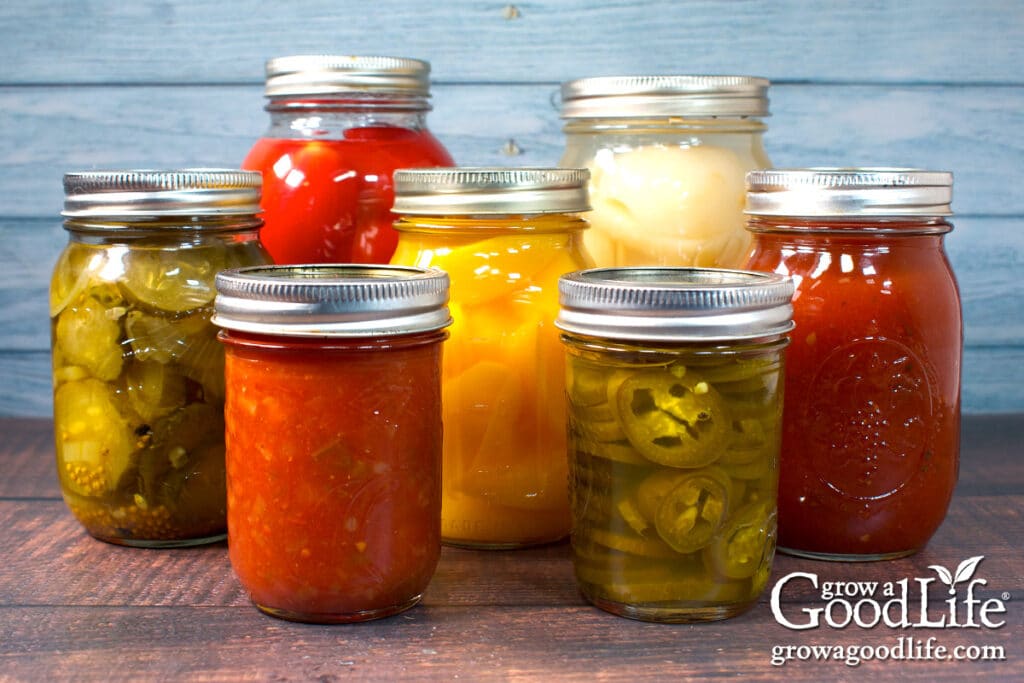
Final Thoughts: If in Doubt, Don’t Can It
Canning is an excellent way to preserve the harvest, but it comes with serious responsibility. If you’re unsure about a recipe’s safety, you don’t have to risk it. You can store the food in the fridge or freezer instead.
Even those of us who love canning can feel uncertain. That’s okay. When we stick with tested recipes, ask questions, and stay up to date, we’re helping keep ourselves and others safe.
Want more guidance? Check out my Safe Canning Guides and sign up for the Grow a Good Life News email newsletter for seasonal canning tips and trusted recipes delivered straight to your inbox.
You May Also Like:
- 6 Tips to Prepare for Canning Season
- Safe Canning Books to Add to Your Library
- Tips for Choosing a Pressure Canner
References and Recommended Reading:
- National Center for Home Food Preservation. Frequently Asked Canning Questions. University of Georgia.
- Avoiding Common Canning Mistakes. Utah State University Extension.
- Which Ball home canning recipe publications are up to date? Ball Mason Jars Help Center. Retrieved June 2025.
- Update Canning Recipes. Penn State Extension.
- What to Look for When Determining the Safety of Home Canning Recipes. University of New Hampshire Extension.
If you love salsa, consider adding our eBook, Grow a Good Life Guide to 50 Salsa Canning Recipes, to your resource library. This 72-page eBook is packed with a variety of delicious salsa recipes, including classic tomato salsas to roasted and grilled salsas to tomatillo and delicious fruit blends, all safe for water bath canning. It’s the perfect guide to help you preserve your garden harvests.

